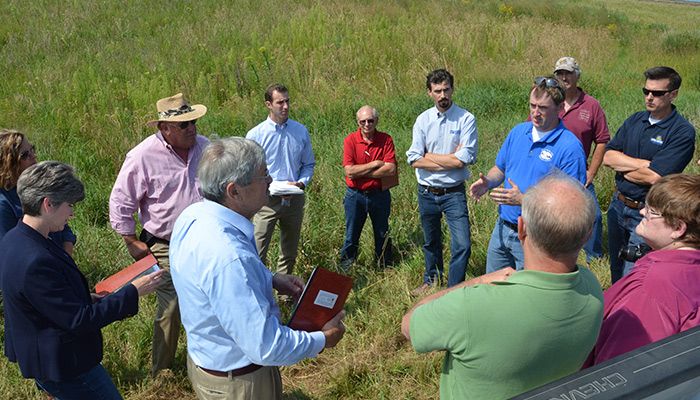Work by farmers and landowners transforms western Iowa lake into a premier fishing spot
Author
Published
9/12/2016
There are many ways to measure the success of Black Hawk Lake restoration efforts, but perhaps the most visible occurred this summer when the 922-acre lake was filled with boatloads of South Dakotans casting for walleye.
“South Dakota fishers, who come from a premier walleye state, they’re coming here to fish walleye,” Ben Wallace, a fisheries biologist for the Iowa Department of Natural Resources, told Iowa Gov. Terry Branstad and Sen. Joni Ernst during a recent tour of watershed improvement efforts in Sac County.
Transforming the Black Hawk Lake into a premier fishing destination wouldn’t have happened without collaboration involving farmers and landowners throughout the watershed, city and county officials, and state and federal agencies, said Dennis Schulte, a Natural Resources Conservation Service (NRCS) district conservationist.
“We wanted everyone involved at the same time so everyone had a stake in it,” said Schulte. “Everyone said, ‘We’re going to do our share,’ and they all wrote their own part (of the conservation plan).”
Reducing sediment
A key part of the plan was reducing sediment and phosphorus flowing into the lake, said T.J. Lynn, Black Hawk Lake watershed project coordinator.
“We try to focus on sediment and phosphorus because the main impediments for Black Hawk Lake are silt and algae,” he said.
Landowner Linda Ritchie installed a 4-acre wetland to control the flow of water coming into a creek on her property that drains into Black Hawk Lake, removing nitrates, phosphorus and sediment in the water.
The wetland filters drainage from nearly 640 acres of cropland, Lynn explained. Ritchie also installed buffer strips along the creek. Her farming tenant, Farm Bureau member Scott Poen, uses several conservation practices including strip-tillage and controlled drainage.
The duo received the 2014 Black Hawk Lake Watershed Conservation Award, which honors landowners and farmers for promoting and implementing conservation practices that improve the health of the watershed.
“I certainly didn’t do all of this conservation work to win an award,” said Ritchie. “I feel really good about the work that is being done on our farm to keep the watershed in better shape. I think a lot of farmers are doing good things in this area.”
Targeted practices
The wetland is a good example of using targeted conservation practices as farmers and others work to achieve the goals of the Iowa Nutrient Reduction Strategy, which aims to reduce nitrogen and phosphorus entering Iowa’s waterways, said Adam Kiel, Iowa Soybean Association environmental services operations manager.“Not every watershed has the same needs,” Kiel said. “Nitrates aren’t the main focus for this project.”
Branstad lauded Ritchie and Poen for their efforts to apply conservation practices that fit the topography of Sac County’s rolling hills.
“The soils are very different than in north-central Iowa where I grew up or eastern Iowa,” he said. “That’s why a one-size-fits-all approach doesn’t work.”
The governor said water quality funding will continue to be one of his top priorities to help replicate the kind of success seen in the Black Hawk Lake watershed with farmers, landowners, cities and counties working toward a common goal.
“I’m glad to see you’ve got the cities and farmers working together,” said Branstad. “It’s going to take collaboration for this to succeed.”

Want more news on this topic? Farm Bureau members may subscribe for a free email news service, featuring the farm and rural topics that interest them most!